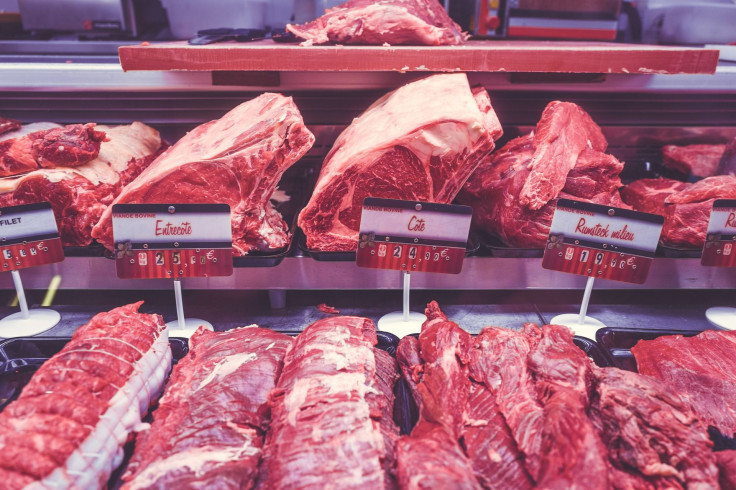Buying And Preparing Red Meat For A Healthy Diet: The Do's And Don'ts

Americans love red meat — from fine cuts of steaks, char-grilled burgers, and barbecued ribs, to processed hot dogs, greasy bacon, and motley bologna. Red meat consumption is at an all-time high in America, rising from an annual consumption of 80 pounds of meat per person in 1940 to more than 180 pounds per person in 2012. But is it all bad? According to the Unites States Department of Agriculture (USDA), there are ways to keep red meat in your diet while maintaining a healthy lifestyle.
When the World Health Organization announced an international team of scientists concluded red meat-laden diets were carcinogenic in 2015, carnivores questioned their diets. The findings, which reviewed more than 800 studies on the link between cancer and meat consumption, led meat eaters to wonder if the shift to a more plant-based diet would decrease their odds of developing colon, stomach, pancreatic, and prostate cancer in men.
Although red meat has been associated with an increased risk of cancer, the USDA allots 2 to 3 ounces of meat (roughly 21 grams of protein) to serve as a protein during a meal, which is roughly the size of a deck of playing cards or the palm of your hand. According to the 2015 Dietary Guidelines, red meat is an excellent source of iron — an essential mineral responsible for transporting oxygen in the blood. Without an adequate amount of iron, the body is at risk for a condition called iron deficiency anemia, which can be especially dangerous for children because it can lead to poor growth and development, and may negatively effect cognitive abilities.
But that doesn’t mean you can eat a few slices of bacon every night because the serving size fits into the palm of your hand. Bacon, hot dogs, and cold cuts are all forms of processed meats, which carry the heaviest toll of cancer risk. Studies have shown consuming 50 grams of processed meat a day significantly increases the risk of heart disease and diabetes. A Big Mac from McDonald’s, for example, consists of two beef patties that weigh in at 45.4 grams each for a whopping total of 90.8 grams of processed meat.
Navigating The Meat Market
By avoiding processed meat and sticking with lean cuts of red meat, carnivores can cut down on their risk of cancer. When walking down the grocery store aisle, look for cuts with “round,” “chuck,” or “loin” in their name, which indicates it’s a lean cut of meat. As a rule of thumb, beef labeled with “select” or “choice” are leaner compared to cuts labeled with “prime.” When buying ground beef, consumers should look for the highest percent of lean beef content, such as 95 percent lean as opposed to 75 percent lean.
After selecting a piece of meat, it’s useful to examine the cut to spot any visible fat. The white along the side of the cut can be trimmed off. Trimming any cut of meat is an important part of the process, but if the fat is marbled throughout the meat (resembling little, white veins) it should be avoided altogether. After trimming the fat with a sharp knife, cut the meat into 3 ounce portions to make controlling the amount you eat an easier process.
For cooking, red meat is often seasoned and then seared, braised, or grilled. Instead of increasing your sodium consumption by sprinkling it onto a slab of meat, choose salt-free alternatives like ground peppercorn, paprika, garlic, chili powder, or lemon juice. Heated oil is often used to prevent the piece of meat from sticking to the pan or grill, but be mindful during preparation because extra virgin olive oil is 119 calories per tablespoon. If you need oil to coat the surface, choose a cooking spray to help reduce the risk of overdoing it.
According to the National Cancer Institute, carnivores also need to watch how they cook their meat. Cooking meat at very highly elevated heat or directly over an open flame can form unhealthy compounds heterocyclic amines (HCAs) and polycyclic aromatic hydrocarbons (PAHs). Both HCAs and PAHs have been found to cause changes in DNA, which can increase the risk of cancer.
Minimize the risk of HCAs and PAHs by turning to gentler methods of cooking, such as stewing and steaming. Limit charred and smoked foods, don’t expose the meat directly to a flame, and keep cooking temperatures below 150 degrees Celsius. By marinating meat in olive oil, lemon juice, garlic, or red wine, meat-eaters can reduce the amount of HCAs by up to 90 percent. If a favorite recipe of yours calls for high heat, just make sure to flip the meat frequently and avoid burning.



























